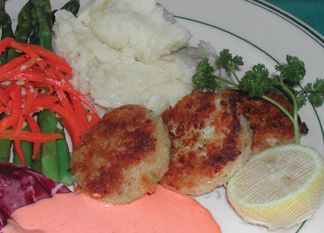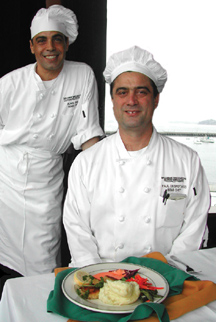McCormick and Kuleto’s Crab Cakes

With Fire-Roasted Red Pepper Aioli
By Mary Swift-Swan
Published: February, 2004
February is the month of romance and a month-long celebration for the Crab Fest of Fisherman’s Wharf of San Francisco. Dungeness Crab is a sweet- tasting rich treat that when fresh is simply fabulous. Dungeness crab can be prepared in many appetizing ways. Some of the specials being created for crab season during Februaryat McCormick and Kuleto’s include: half a crab with drawn butter; a Cobb salad mixed with shrimp and scallops from the Bay; a mixed seafood steam of clams, Dungeness crab, mussels and crawfish: braised whole Dungeness crab; and Tortellini with Dungeness crab and creamy blue cheese sauce. But it is Crab Cakes that are the standard by which Bill McCormick and Doug Schmicks measure the quality of their 42 restaurants around the country.
When Bill and Doug tour their many restaurants, it is Crab Cakes they order. Crab Cakes have to stand out as not just tasty, but chefs at each restaurant must meet the bar of excellence required in all their restaurants, judged by their Crab Cakes. Sous Chef Paul Despotakis did not hesitate when asked to share a recipe of the signature Crab Cakes dish from the group’s flag ship restaurant McCormick and Kuleto’s in Ghirardelli Square, San Francisco. They are surprisingly simple to make, a true delight, and considered quite a romantic dish to serve to someone special.
The Internet abounds with prepared Crab Cakes that can be ordered for $49.99 for six frozen standard- size crab cakes. At McCormick and Kuleto’s, 3-3oz Crab Cakes are only $13.75 and they’re made with fresh Dungeness Crab served hot in one of the most beautiful and romantic restaurants on San Francisco’s waterfront. The restaurant’s panoramic views overlooking Aquatic Park, across the Bay past Alcatraz to Angel Island, is beautiful day or night in any kind of weather.
Preparing Crab Cakes
Put the red pepper and garlic in the oven. Clean fresh crab picking meat from legs and body. If using canned crab, let drain for 15 minutes. Do not squeeze excess water out.
Grind celery and onion in an automatic chopper or hand mince til fine. Mix celery, onion, mayonnaise, egg, cayenne, mustards, Worcestershire Sauce, salt and pepper, and Old Bay seasonings. Mix well, then add 2 oz Panko bread crumbs and blend. Let mixture rest while the crab is draining, at least 10 minutes to allow the flavors to meld. While the crab drains and the vegetables rest, start the Aioli.
Note: Egg and bread crumbs quiet the flavor of crab but they are needed to bind the mixture to form a cake that holds together. Spices, like Cayenne, Old Bay, and garlic with lemon, bring out the flavor reaching through and enhancing the binders.
Add the crab and fold it in. Do Not Over Mix. Add the lemon juice to the remaining Panko bread crumbs then blend them in mixing gently to not break up the crab meat.
Form balls of the mixture. Press the balls into the bread crumbs to coat the outside and set on parchment paper.
Press the balls into a form that makes approximately 3 oz cakes when finished.
Heat Canola oil on a griddle or in heavy frying pan on medium high. Heat the Crab Cake through until the flat side on the griddle turns golden brown. Turn and brown the other side and serve.
Red Pepper Aioli
Core the pepper and remove the seeds, then split into thirds. Place the garlic cloves on a cookie sheet in a 300-degree oven. Brush the outside of the pepper with oil. When the garlic is slightly transparent and browned, it is roasted. The pepper skins should be partly blackened from the olive oil. Place the peppers in a paper bag. Remove the garlic from the tray to a cutting board but leave the oven on. Run water from the sink over the bag with the peppers in it and return the entire bag to the tray in the oven til it is dry. The pepper skin will peel off easily. Remove as much skin as possible. Mince the garlic and slicethe pepper into thin strips.
Add the aioli or mayonnaise, lime juice, and zest, chives, minced garlic, red pepper and Tabasco sauce to a small sauce pan, mix, and warm on low heat. Bring slowly to a simmer stirring often enough to keep the aioli from breaking. Serve warm under the Crab Cakes.
Chef Paul Despotakis is a San Francisco native. He said his family was very Greek and “…the noisiest family on the planet with five brothers and sisters. We all ate every meal together without a TV, just family. That is part of what I think is missing in America today. Eating together really contributes to a strong social fabric.” Paul’s father was an Officer in the Marines and later became a computer Greek. When asked if the movie ‘My Big Fat Greek Wedding’ rang true? Paul laughed, “ That was really close and I’m getting married this May. So my lovely bride-to-be can really relate to it. Katrin is of German decent and she is leaning all about my noisy family. The wedding will be right here in Aquatic Park with the reception in McCormick and Kuleto’s banquet room. The room is great and views are inspiring.” Paul learned to cook at home from his family by helping his father’s father. Grandpapa was a professional chef. His mother owned a successful catering company for many years. Paul was the only one of all his brothers and sisters who was not periodically fired by Mom.
Paul’s first creative outlet was dance. He studied and danced with the San Francisco Ballet Company from an early age. After graduating from Cal Berkeley in 1978 as a math major, Paul left for New York where he “danced through the ‘80s” with several companies including the Metropolitan Opera until he was 35. Returning to San Francisco in the early ‘90s, Paul then explored his second passion. “I always new that my next creative outlet would be cooking.” Starting as a dishwasher in restaurants, he learned from all those he worked with. Moving up to the position as line chef, working with Catering to the Stars, and as a personal chef, he is now the acting Exectutive Sous Chef at McCormick and Kuleto’s.
Paul starts his day at the restaurant at 5:45am , opening the kitchen as the night cleanup crew are finishing. Daily deliveries begin arriving at 6am. The morning staff begin arriving at 6:30. While the staff begin regular preparations, Paul and. Zak decide on the day’s ever-changing specialties inspired by fresh catch and market treasures. Cooking begins at 7:30am and slows around 2pm. Paul explained why he particularly liked the hours. “The night staff come in from other jobs and do not have down moments together. The morning schedule is busy but it does afford more time for us to be creative. Many of us eat together during breaks so there is comraderie among the staff plus I can make some time to train those interested in learning how to cook. College has helped in dealing with reports and math aids in ordering. I’d have to say my expertise has come about by learning in the home and the work environment. Zak learned in culinary schools of Europe and has traveled all over the world as a chef.
Teaching him the styles of McCormick and Kuleto’s is fun. We are both learning. Ecellence often comes from a desire to improve each day, fueled by a passion for cooking.”



